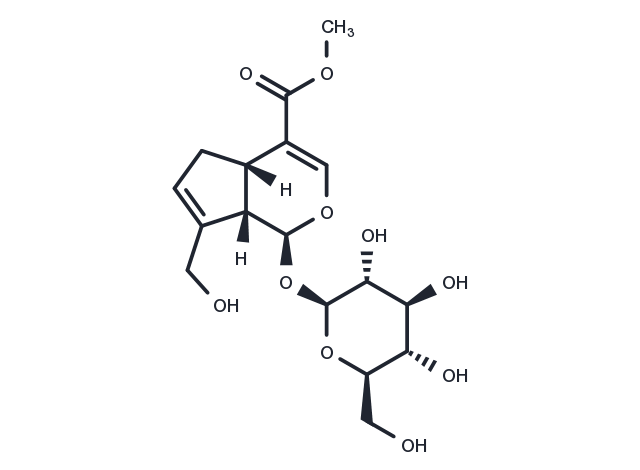Powder: -20°C for 3 years | In solvent: -80°C for 1 year


Geniposide is an iridoid glycoside with a variety of biological activities including neuroprotective, anti-diabetic, antiproliferative, and antioxidative activity. Geniposide has been shown to regulate Nrf2 translocation.

| Pack Size | Availability | Price/USD | Quantity |
|---|---|---|---|
| 100 mg | In stock | $ 60.00 | |
| 1 mL * 10 mM (in DMSO) | In stock | $ 45.00 |



| Description | Geniposide is an iridoid glycoside with a variety of biological activities including neuroprotective, anti-diabetic, antiproliferative, and antioxidative activity. Geniposide has been shown to regulate Nrf2 translocation. |
| In vitro | Geniposide demonstrates multifaceted bioactivities, including antithrombotic, anti-inflammatory, antidiabetic, anti-atherosclerotic, antidepressant effects, and therapeutic potential for Alzheimer's disease (AD), anti-hypertensive, and toxicological effects, alongside managing adverse reactions[1]. It significantly reduces IL-8, IL-1β, and MCP-1 production in OGD-induced brain microvascular endothelial cells, markedly downregulates P2Y14 receptor expression, and inhibits the phosphorylation of RAF-1, MEK1/2, and ERK1/2[2]. |
| In vivo | Geniposide, administered at doses of 200 and 400 mg/kg, has been observed to significantly reduce blood glucose, insulin, and triglyceride (TG) levels in a dose-dependent manner in diabetic mice. Additionally, it diminishes the expression and enzymatic activity of glucose-6-phosphatase (G6Pase) and glycogen phosphorylase (GP) at both mRNA and protein levels. At dosages of 20.0, 40.0, or 80 mg/kg, geniposide effectively counters the excessive elevation of serum alanine transaminase/aspartate transaminase (ALT/AST) and hepatic lipid peroxidation (LPO) levels induced by alcohol, signifying its potent hepatoprotective properties. Furthermore, it enhances the expression of heme oxygenase-1 (HO-1), mitigating cell apoptosis in primary cultured hippocampal neurons caused by 3-morpholinosydnonimine hydrochloride (SIN-1). In addition to its neuroprotective and hepatoprotective effects, geniposide exhibits anti-thrombotic activity in a photochemistry-induced thromboembolism model in vivo and acts as an effective inhibitor of Nuclear Factor kappa B (NF-κB) activity by preventing IκB degradation. |
| Cell Research | The third passages of brain microvascular endothelial cells (BMECs) are used for the experiment. The BMECs are divided into four groups: (1)normal control group: the normal cultured BMECs without treatment; (2)OGD group: the BMECs injured by OGD according to the above method; (3) geniposide group: the OGD-injured BMECs treated with 33.2 μg/mL geniposide for 6 h; (4)PTX group: the OGD-injured BMECs administrated with 100 ng/mL PTX. PTX, known as an inhibitor of Gi-coupled receptor is used to assess the activation of P2Y14 receptor induced by OGD in this experiment[2]. |
| Source |
| Molecular Weight | 388.37 |
| Formula | C17H24O10 |
| CAS No. | 24512-63-8 |
Powder: -20°C for 3 years | In solvent: -80°C for 1 year
DMSO: 32 mg/mL (82.4 mM)
You can also refer to dose conversion for different animals. More
bottom
Please see Inhibitor Handling Instructions for more frequently ask questions. Topics include: how to prepare stock solutions, how to store products, and cautions on cell-based assays & animal experiments, etc.
Geniposide 24512-63-8 Microbiology/Virology Neuroscience Influenza Virus Beta Amyloid β-amyloid peptide Inhibitor inhibit Amyloid-β Abeta inhibitor
